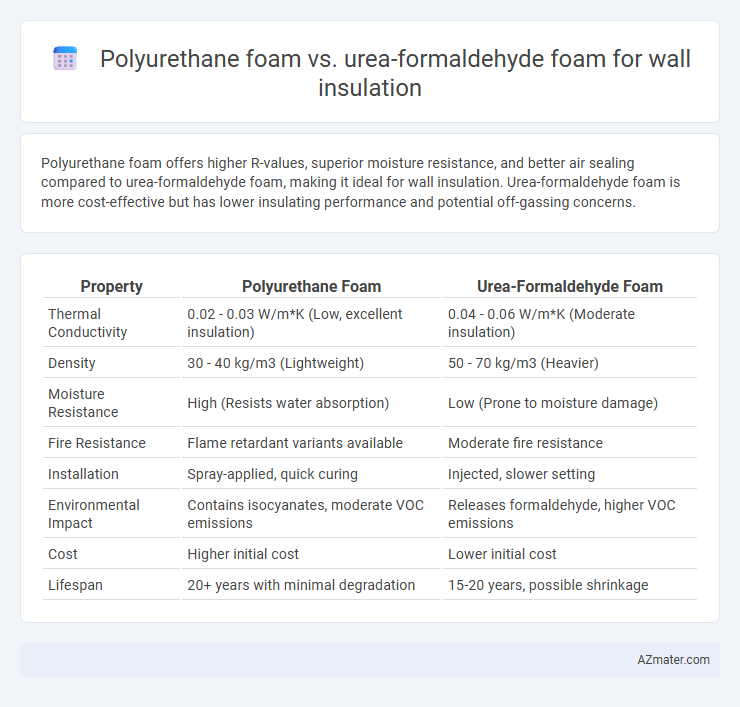Polyurethane foam offers higher R-values, superior moisture resistance, and better air sealing compared to urea-formaldehyde foam, making it ideal for wall insulation. Urea-formaldehyde foam is more cost-effective but has lower insulating performance and potential off-gassing concerns.
Table of Comparison
| Property | Polyurethane Foam | Urea-Formaldehyde Foam |
|---|---|---|
| Thermal Conductivity | 0.02 - 0.03 W/m*K (Low, excellent insulation) | 0.04 - 0.06 W/m*K (Moderate insulation) |
| Density | 30 - 40 kg/m3 (Lightweight) | 50 - 70 kg/m3 (Heavier) |
| Moisture Resistance | High (Resists water absorption) | Low (Prone to moisture damage) |
| Fire Resistance | Flame retardant variants available | Moderate fire resistance |
| Installation | Spray-applied, quick curing | Injected, slower setting |
| Environmental Impact | Contains isocyanates, moderate VOC emissions | Releases formaldehyde, higher VOC emissions |
| Cost | Higher initial cost | Lower initial cost |
| Lifespan | 20+ years with minimal degradation | 15-20 years, possible shrinkage |
Introduction to Wall Insulation Materials
Polyurethane foam offers superior thermal resistance with an R-value typically ranging from 6 to 7 per inch, making it highly effective for wall insulation compared to urea-formaldehyde foam, which has an R-value closer to 4 per inch. Polyurethane foam also provides excellent air sealing and moisture resistance, contributing to enhanced energy efficiency and durability in building envelopes. Urea-formaldehyde foam, while cost-effective and easier to install, may release formaldehyde gas over time, raising indoor air quality concerns and making it less favorable for modern insulation standards.
Overview of Polyurethane Foam
Polyurethane foam stands out in wall insulation due to its high R-value per inch, typically ranging from 6 to 7, which provides exceptional thermal resistance compared to other materials. Its closed-cell structure offers superior moisture resistance and air sealing properties, reducing energy loss and enhancing indoor comfort. The material's flexibility and durability contribute to long-term performance, making it a preferred choice for energy-efficient building envelopes.
Overview of Urea-Formaldehyde Foam
Urea-formaldehyde foam insulation (UFFI) is a rigid foam known for its high insulating properties and was widely used in wall insulation during the mid-20th century. It is created by mixing urea, formaldehyde, water, and a foaming agent, resulting in a lightweight, closed-cell structure that effectively reduces heat transfer. Concerns over formaldehyde off-gassing and potential health risks have limited its use compared to polyurethane foam, which offers superior thermal performance and chemical stability.
Thermal Performance Comparison
Polyurethane foam exhibits superior thermal performance compared to urea-formaldehyde foam, with a typical R-value ranging from 6 to 7 per inch, whereas urea-formaldehyde foam has an R-value around 4 to 5 per inch. The closed-cell structure of polyurethane foam enhances its insulating properties by minimizing air infiltration and thermal bridging. Urea-formaldehyde foam tends to have higher thermal conductivity and is more prone to moisture absorption, which can reduce its long-term insulation effectiveness.
Moisture Resistance and Durability
Polyurethane foam offers superior moisture resistance compared to urea-formaldehyde foam, making it ideal for wall insulation in humid or wet environments due to its closed-cell structure that prevents water absorption. Urea-formaldehyde foam, while cost-effective and providing reasonable thermal insulation, is more susceptible to moisture degradation, which can compromise its durability and insulation performance over time. Polyurethane foam also demonstrates enhanced longevity and structural integrity, ensuring sustained insulation efficiency and reduced maintenance costs in wall systems.
Installation Process and Application
Polyurethane foam offers a seamless installation process through spray application, expanding to fill gaps and providing superior air sealing in wall insulation. Urea-formaldehyde foam requires precise mixing and injection into wall cavities, demanding professional handling due to its chemical composition and potential health risks. Polyurethane's quick curing time enhances application efficiency, whereas urea-formaldehyde foam is primarily suited for retrofit insulation in older homes with existing wall cavities.
Health and Safety Considerations
Polyurethane foam offers superior air sealing but may release isocyanates during application, requiring proper ventilation and protective gear to prevent respiratory irritation. Urea-formaldehyde foam emits formaldehyde, a known carcinogen, posing long-term health risks if not properly cured and sealed. Choosing low-emission, certified formulations and ensuring professional installation minimizes exposure to harmful chemicals in both insulation types.
Environmental Impact and Sustainability
Polyurethane foam offers superior thermal insulation but relies on petrochemical sources and emits greenhouse gases during production, raising environmental concerns. Urea-formaldehyde foam, derived from more abundant raw materials, has a lower global warming potential but can release formaldehyde, posing indoor air quality risks. Sustainable wall insulation choices balance the reduced carbon footprint of urea-formaldehyde foam with the efficiency and lifespan benefits of polyurethane foam, necessitating careful evaluation of material sourcing and emissions.
Cost Analysis and Long-Term Value
Polyurethane foam offers higher initial costs compared to urea-formaldehyde foam but delivers superior R-values and longer durability, enhancing energy efficiency and reducing utility bills over time. Urea-formaldehyde foam is less expensive upfront but may suffer from settling and diminished insulating properties, leading to potential increased maintenance and replacement expenses. Evaluating total cost of ownership, polyurethane foam provides better long-term value through improved thermal performance and structural integrity in wall insulation applications.
Which Foam is Best for Your Wall Insulation?
Polyurethane foam offers superior thermal insulation with an R-value of approximately 6.5 per inch, providing excellent air sealing and moisture resistance, making it ideal for energy-efficient wall insulation. Urea-formaldehyde foam has a lower R-value around 4.4 per inch and can emit formaldehyde gases, posing potential health risks and reducing indoor air quality. For long-term durability, enhanced energy savings, and safer indoor environments, polyurethane foam is generally the best choice for wall insulation.

Infographic: Polyurethane foam vs Urea-formaldehyde foam for Wall Insulation
 azmater.com
azmater.com